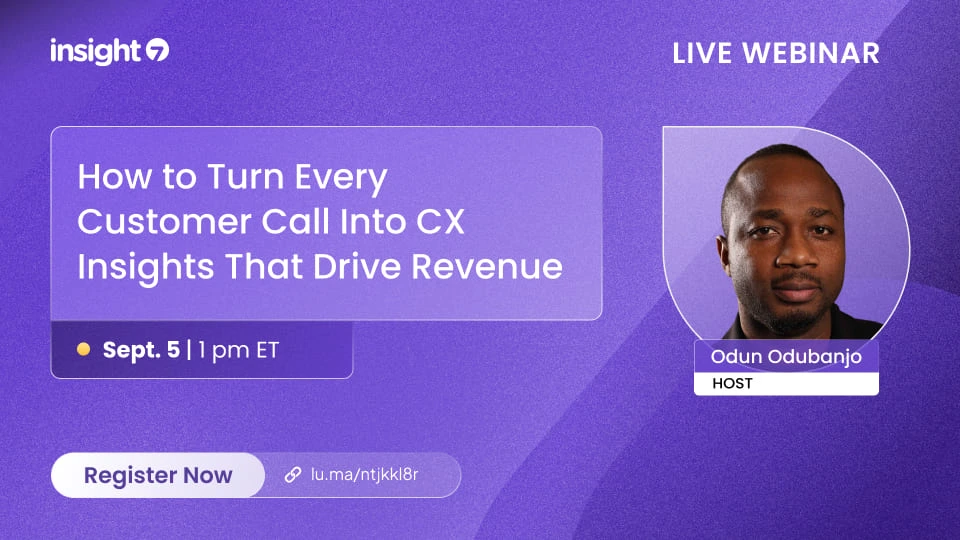Speech Analytics Solution: Complete Guide
-
Bella Williams
- 10 min read
Voice Data Insights are revolutionizing how businesses understand customer interactions. As voice communication remains a key touchpoint, analyzing spoken conversations can unlock a wealth of insights. Every call tells a story, revealing customer pain points, desires, and behaviors that can inform strategic decisions and enhance user experiences.
Speech analytics solutions empower organizations to tap into these insights seamlessly. With intuitive tools, anyone can access the data without needing extensive training. This democratization allows teams to discover valuable information from customer interactions and drive action based on real feedback, creating a feedback loop that fosters continuous improvement and innovation.
Generate visualizations from your qualitative data. At Scale.

Exploring Voice Data Insights: Speech Analytics Technologies
To explore voice data insights, it's essential to understand the underlying speech analytics technologies. These technologies have transformed how businesses analyze and interpret voice data, allowing them to glean valuable insights from customer interactions. By utilizing advanced machine learning algorithms and natural language processing, organizations can transcribe audio recordings into readable text. This initial step is crucial, as it creates a foundation for deeper analysis.
Once transcripts are generated, various analytical techniques can be applied. Techniques such as sentiment analysis, keyword extraction, and conversation summarization help illuminate customer sentiments and highlight emerging trends. Additionally, integrating templates for specific objectives enables users to focus on areas such as voice of the customer feedback or customer pain points. Ultimately, effective use of these technologies leads to actionable insights that can enhance decision-making and improve customer experiences.
Key technologies driving speech analytics include:
- Automatic Speech Recognition (ASR): Converts audio to text, making analysis accessible.
- Natural Language Processing (NLP): Enables sentiment analysis and keyword extraction from transcripts.
- Machine Learning Algorithms: Identify patterns and trends within large datasets, facilitating deeper insights.
By leveraging these technologies, businesses can unlock significant voice data insights, fostering a greater understanding of their customers and improving service delivery.
Understanding the Basics of Voice Data Insights
Voice Data Insights form the backbone of understanding customer interactions and improving services. By analyzing recorded conversations, organizations can uncover trends, identify customer pain points, and enhance overall experiences. This journey into voice data begins with the systematic collection of audio data, converting it into transcripts, and then analyzing it for meaningful insights.
To effectively utilize Voice Data Insights, organizations should follow several steps. First, capture diverse audio interactions, ensuring a wide range of scenarios and customer sentiments are represented. Second, employ speech analytics tools that can automatically transcribe calls and highlight critical insights such as customer frustrations or positive experiences. Finally, foster a culture of data-driven decisions within the team by sharing insights regularly, encouraging collaborative problem-solving. Through this approach, organizations can transform voice data into actionable strategies that enhance customer satisfaction and drive growth.
Key Technologies Driving Speech Analytics Solutions
To unlock the full potential of speech analytics solutions, specific technologies play a crucial role. Among these, natural language processing (NLP) stands out as a key driver for extracting meaningful Voice Data Insights. NLP enables systems to understand and interpret human language, allowing organizations to analyze customer conversations with unprecedented accuracy. This technology simplifies the process of transforming raw audio into actionable insights, thereby enhancing decision-making capabilities.
In addition to NLP, machine learning algorithms work behind the scenes to improve the analysis over time. These algorithms learn from data patterns and user interactions, allowing for the continuous refinement of insights drawn from conversations. Furthermore, cloud computing provides the necessary infrastructure to facilitate real-time processing and analysis of large volumes of voice data. With these technologies, businesses can efficiently capture, transcribe, and analyze customer interactions, leading to deeper understanding and improved service delivery.
Evaluate Performance on Customer Calls for Quality Assurance.
Implementing Speech Analytics Solutions for Better Insights
Implementing speech analytics solutions begins with a clear understanding of your business needs. Start by evaluating specific areas where insights can drive improvement, be it customer service, sales, or operational efficiency. This introspective approach ensures that your chosen solution aligns with your organizational goals.
Next, selecting the right tools and vendors is crucial. Research vendors that specialize in speech analytics and assess their technologies based on user-friendliness, scalability, and data security. Afterward, focus on data collection and preparation. This involves transcribing audio files and organizing call data for optimal analysis.
Once the integration is complete, follow best practices to maximize voice data insights. Regularly monitor performance metrics to refine processes and enhance decision-making. By taking these steps, organizations can effectively leverage speech analytics to extract valuable insights that improve overall business performance.
Steps to Integrate Speech Analytics Solutions Effectively
To successfully integrate speech analytics solutions, it’s essential to follow systematic steps that ensure you gain valuable Voice Data Insights. Begin by identifying your business needs, which involves determining what specific issues you want to address, whether they relate to customer service, sales, or product feedback. This clarity will help in selecting the right tools tailored to meet those objectives.
Next, choose appropriate vendors that specialize in speech analytics technology. Researching their capabilities, customer support, and integration options is vital. After selecting the right tools, focus on data collection and preparation. Gather audio recordings and ensure they are properly formatted for analysis. This foundational work will empower your team to use the analytics platform effectively, leading to actionable insights. With these steps completed, you can harness the full potential of voice data analytics to drive strategic decisions.
Step 1: Identifying Business Needs
Identifying business needs is the critical first step in designing an effective speech analytics solution. By understanding the specific challenges and goals of your organization, you can tailor your voice data insights to meet these requirements. Engaging with various stakeholders, such as sales teams and customer support staff, can help uncover pain points and opportunities. This consultative approach goes beyond just processing calls; it allows for a deeper understanding of customer interactions and market dynamics.
It is essential to focus on specific objectives you aim to achieve with voice data analysis. For instance, improving customer satisfaction, enhancing training programs, and increasing sales efficiency are common goals. To support this process, consider the following aspects:
- Gather Input from Teams: Solicit feedback from customer-facing departments about their experiences and needs regarding the analytics solution.
- Define Success Metrics: Establish clear metrics that will guide your evaluation of the speech analytics tools.
- Prioritize Insights: Determine which insights will provide the most value to your organization.
By carefully examining these elements, you set the foundation for effective data utilization, allowing you to make informed decisions that align with your business objectives.
Step 2: Selecting the Right Tools and Vendors
Selecting the right tools and vendors is crucial to implementing effective speech analytics solutions. Begin by evaluating the specific needs of your business, ensuring the tools can provide meaningful Voice Data Insights tailored to your unique objectives. It’s essential to consider the scalability of the tools and how well they integrate with your existing systems. Engage vendors who specialize in your industry for targeted solution offerings.
Next, assess the features and functionalities of different tools. Prioritize platforms that offer robust analytics, real-time reporting, and intuitive user interfaces. Solicit demos and trial periods to experience their capabilities firsthand. Additionally, check for vendor support and training resources, as these can significantly impact your team's ability to utilize the system effectively. Ultimately, your aim should be to choose tools that not only meet your requirements but also enhance your capability to derive actionable insights from voice data.
Step 3: Data Collection and Preparation
Collecting and preparing data is a critical step in deriving meaningful insights from voice data. This stage ensures that the raw data gathered from various interactions is refined to uncover valuable patterns and trends. A thorough data preparation process involves cleaning the data, removing any irrelevant or duplicated information, and organizing it appropriately for analysis.
To effectively achieve this, consider the following key actions:
Data Acquisition: Identify the sources from which voice data will be collected, such as customer calls, voice recordings, or transcriptions.
Data Cleaning: Eliminate noise from the data, including background sounds or irrelevant portions, to ensure clarity.
Data Structuring: Organize the cleaned data into usable formats that can facilitate analysis, like spreadsheets or databases.
By following these steps, you can create a solid foundation for extracting valuable voice data insights that lead to informed decision-making.
Best Practices for Maximizing Voice Data Insights
To maximize voice data insights, it's crucial to establish a systematic approach. Start by ensuring high-quality audio recordings. Clear audio enhances transcription accuracy and leads to better insights. Next, utilize advanced transcription tools that can process multiple files simultaneously. This efficiency allows you to quickly analyze large volumes of data, turning conversations into actionable metrics.
In the analysis stage, focus on extracting specific insights that align with your business objectives. Identify key themes and common pain points from customer interactions. This targeted analysis not only streamlines the process but also provides a clearer understanding of customer sentiments. Emphasizing collaboration between teams can deepen insights, allowing for comprehensive solutions that address discovered challenges. With a structured approach and team involvement, voice data insights can drive strategic decisions that enhance overall business performance.
Conclusion: Harnessing Voice Data Insights for Business Success
Harnessing voice data insights can transform how businesses understand their customers and improve their offerings. By analyzing conversations, organizations can identify pain points, preferences, and customer sentiments that drive decision-making. This strategic approach not only enhances customer experience but also empowers organizations to address challenges proactively.
To achieve business success, companies must embrace voice data insights as a vital resource. As teams gain access to actionable data, they become better equipped to tailor solutions that resonate with customer needs. This shift towards data-driven strategies paves the way for improved outcomes and competitive advantage in today's dynamic market.







